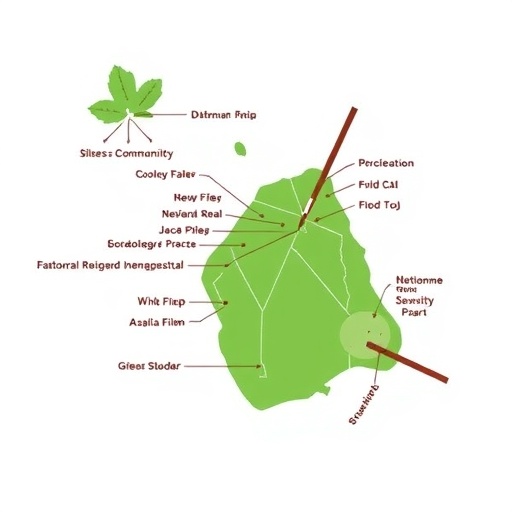In the face of escalating global challenges such as biodiversity loss and the rise of non-communicable diseases, a pioneering study led by researchers at the University of Hawaiʻi at Mānoa sheds light on the critical role of Indigenous agroforestry systems in addressing these intertwined issues. Published in the upcoming July 2025 edition of Global Food Security, this experimental research unpacks the complex yet synergistic relationships between ecological functional diversity and nutritional functional diversity within traditional agroforests in Fiji. By dissecting the intricate trait-based attributes of plant species in these agroecosystems, the team reveals that greater ecological resilience is inextricably linked to enhanced nutritional outcomes, charting a path toward more sustainable, climate-resilient food production models.
Agroforests, distinct in their mimicry of natural forest ecosystems, integrate diverse trees and crops into a single, multifunctional land-use system. Unlike conventional agriculture, which typically prioritizes monocultures and high-yield outputs often at the expense of ecological stability, agroforestry embraces biodiversity as a cornerstone for both environmental and human health. The study uniquely operationalized this concept by examining 48 Indigenous agroforests spanning Fiji’s diverse landscapes through a trait-based analytical framework. This methodology prioritizes plant characteristics relevant to ecological resilience—such as seed dispersal mechanisms and growth patterns—and human nutritional value, focusing on macro- and micronutrients including carbohydrates, vitamin A, and zinc.
The results are compelling: agroforests that boast a rich array of functional ecological traits also cultivate a broader spectrum and higher quality of nutrients essential for human health. This dual diversity essentially acts as an ecological and nutritional buffer, able to absorb climatic shocks such as extreme weather events while ensuring the maintenance of nutrient-rich food supplies. The implication is clear—agroforestry systems that amplify plant trait variation engender robust, multifunctional landscapes capable of supporting both biodiversity and community well-being.
This research not only highlights the environmental advantages of such systems but underscores their vital contribution to human nutritional security. In an age where intensive agriculture often favors volume over quality, leading to nutrient-poor diets and the widespread proliferation of diet-related chronic conditions, agroforests represent a paradigm shift. Their ecologically complex matrix fosters an abundance of edible and medicinal resources, thereby enriching local diets and potentially mitigating malnutrition and micronutrient deficiencies.
Lead author Ashley McGuigan articulates the significance of these findings with clarity and urgency. She emphasizes Fiji’s agroforests as emblematic of how biodiverse agroecosystems contribute to agriculture that is simultaneously climate-resilient and nutrition-sensitive. McGuigan advocates for food systems that are locally rooted, adaptive to environmental fluctuations, and inherently supportive of community health. “The intricate relationships between biodiversity and nutrition within these agroforests offer a blueprint for sustainable food production in a changing climate,” she states.
Integral to the study’s conclusions is the acknowledgment of Indigenous knowledge systems, which have stewarded these agroforests for millennia. These culturally embedded management practices, honed over generations, are deeply attuned to the local ecological and social conditions, fostering resilience against a range of natural disturbances. Their capacity to fine-tune biodiversity to balance ecosystem functions and nutritional outputs stands in stark contrast to mechanized, one-dimensional agricultural methods. The perpetuation and support of such Indigenous practices emerge from this research as non-negotiable for building resilient, future-proof food systems.
The researchers advocate strongly for policy and investment that recognize and elevate Indigenous and agroecological food production frameworks, not only within the Pacific region but globally. They call for collaborative efforts with local practitioners to expand trait-based research and design innovative food production systems that concurrently enhance ecological sustainability and human nutrition. This evidence-based approach seeks to bridge the often-disconnected spheres of environmental management and public health, urging policymakers to foster systems that reflect their interconnectedness.
The study’s methodology deserves particular mention for its pioneering integration of trait-based ecology with nutritional science. By quantifying both ecological resilience traits and nutritional functional traits, the researchers transcended traditional biodiversity metrics that often ignore the functional implications of species traits. This nuanced approach offers a scalable model for assessing and designing diverse agroecosystems worldwide, emphasizing function over mere species counts, and focusing on outcomes that matter most—climate resilience and nutritional sufficiency.
Beyond theoretical insights, the practical implications for Fijian communities are profound. Food production remains fundamental to Fiji’s rural livelihoods, underpinning approximately 80% of rural economies and providing direct food security. However, increased reliance on food imports exposes these communities to vulnerabilities stemming from global supply chain disruptions and economic shocks. Investing in and scaling up diverse, Indigenous-led agroforests can bolster local autonomy over food systems, increase resilience to climate variability, and improve dietary quality.
The collaboration underlying this study encompasses a broad network of expertise spanning multiple institutions, including the University of Hawaiʻi at Mānoa, The University of the South Pacific, and Harvard University. This multidisciplinary approach melds ecological theory, nutritional science, and Indigenous studies to deliver comprehensive insights that transcend academic silos.
As global agriculture faces rising pressures—from climate change to nutritional crises—the call for integrative solutions like Indigenous agroforestry grows ever more urgent. This research not only compels a reevaluation of how food systems are structured but invites a paradigm shift that centers biodiversity and local knowledge at the core of sustainable development.
In summary, the study unveils a compelling narrative: ecological functional diversity and nutritional functional diversity are intricately linked within complex agroforests, offering a powerful synergy that can reshape agricultural paradigms. Embracing such systems could be pivotal in forging resilient, healthful, and sustainable food futures, especially for regions vulnerable to climate variability and food insecurity. The findings thus resonate far beyond Fiji, illuminating pathways toward equitable and ecologically attuned food management worldwide.
Subject of Research: Not applicable
Article Title: Ecological functional diversity predicts nutritional functional diversity in complex agroforests
News Publication Date: 19-Jul-2025
Web References: http://dx.doi.org/10.1016/j.gfs.2025.100870
Image Credits: Credit: UH
Keywords: Agroforestry, Forestry, Agriculture, Sustainable agriculture, Sustainability




